I want each tenant to have:
Separate DB (one per tenant)
Shared base code and core modules
Custom modules per client
White-label branding managed from UI (not code)
Easy CI/CD for updates and Docker deployments
Any recommended Git structure or deployment best practices for scalability and maintenance?
